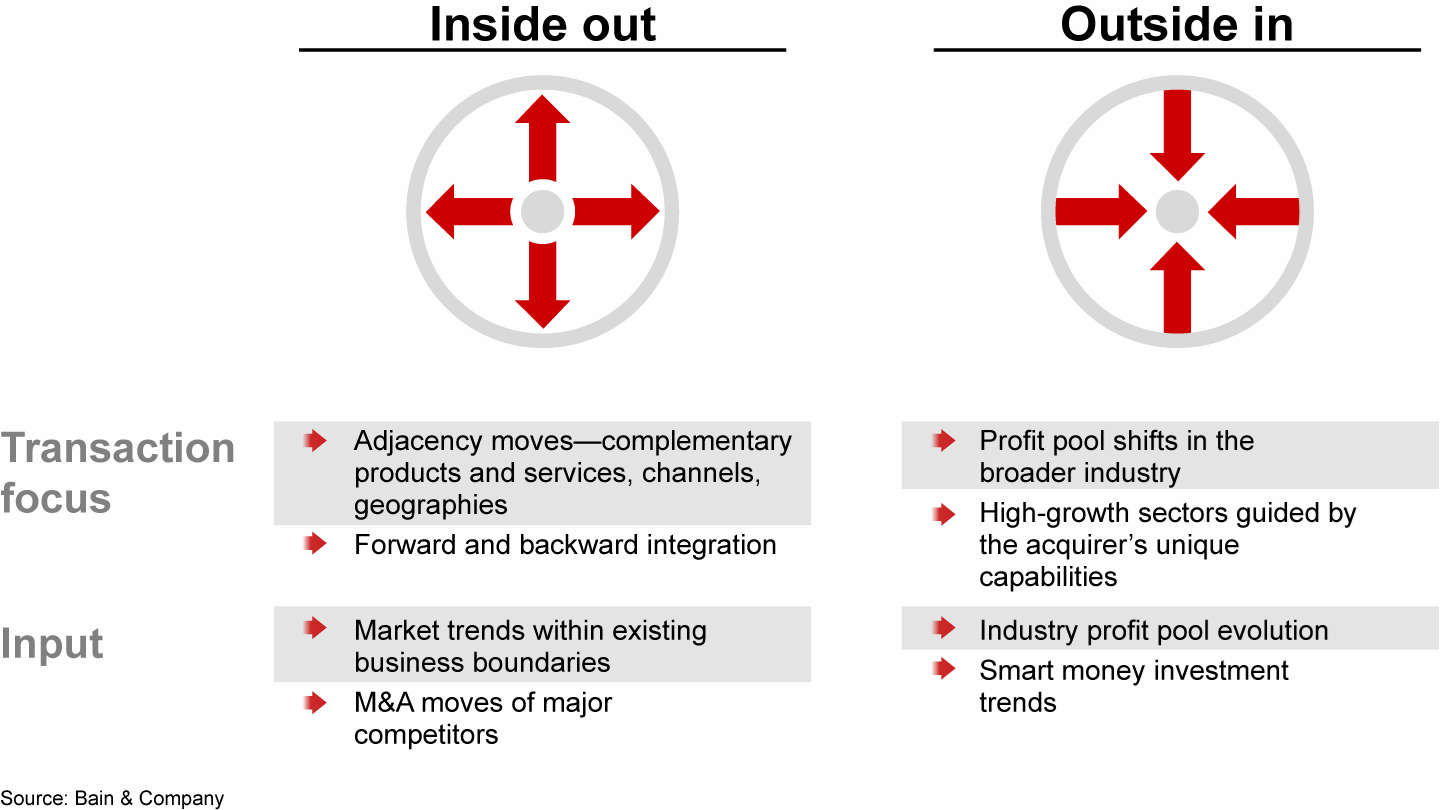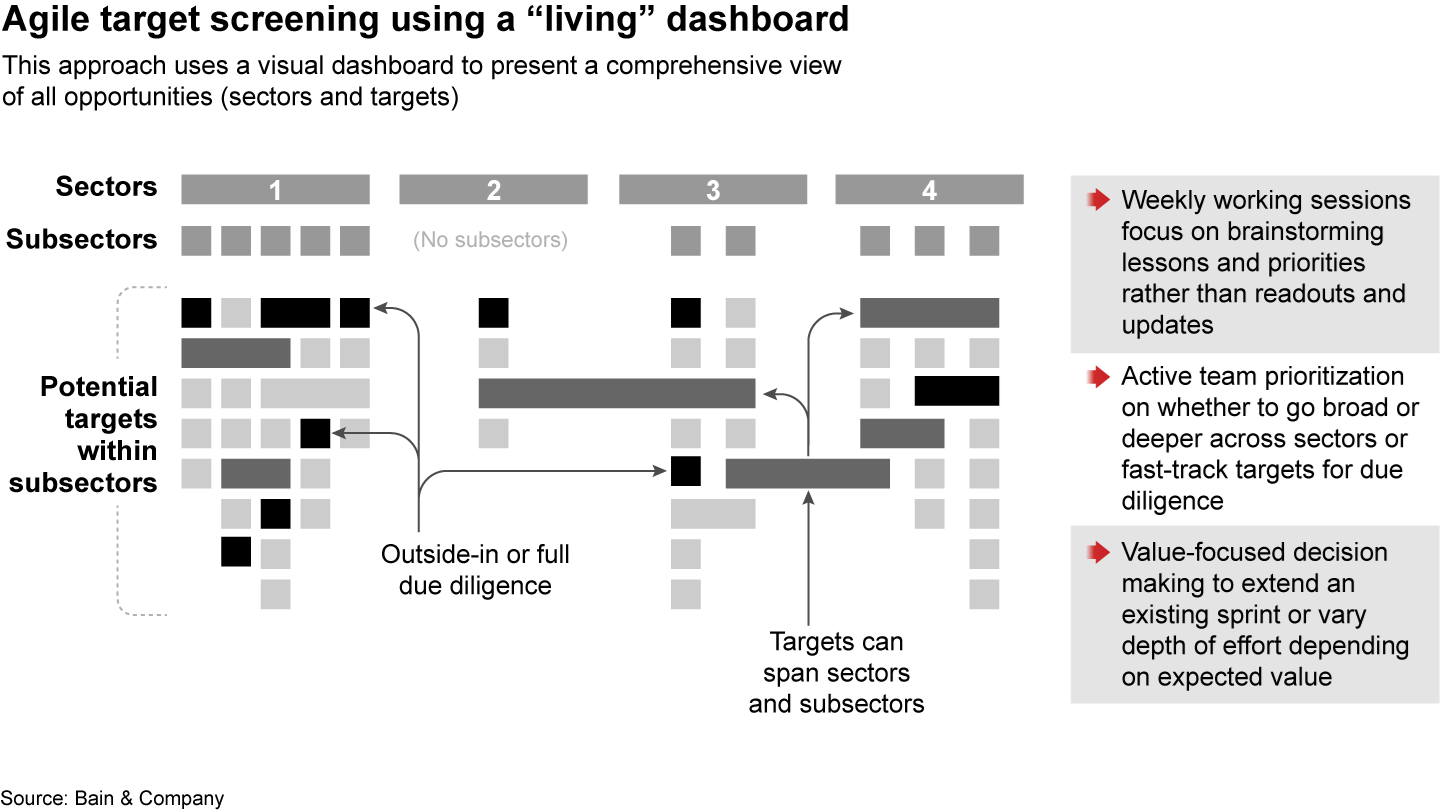Report

Executive Summary
- A differentiated end-to-end M&A capability that links directly to the corporate growth strategy is the common denominator of the most successful companies.
- One of the cornerstones of a strong M&A capability is an ongoing and systematic search for acquisition targets as well as early relationship building.
- In today’s disruptive environment, traditional target screening is rapidly evolving into developing broader market-sensing capabilities as corporate growth strategy demands developing new growth engines.
- New approaches enable you to widen the aperture on sectors and targets and expand your understanding of the broader ecosystem.
This article is Section 4.1 of Bain's 2020 Global Corporate M&A Report. Explore our latest annual M&A report here.
Ongoing target identification underpins the M&A capabilities of leading acquirers
Leadership begets leadership. One of the advantages of being a leader is the information advantage. From a higher vantage point, it is easier to not only spot market trends, emerging technologies and business models but also any acquisition opportunities that come on the market.
Consider this quote: "If anyone in the world wants to sell a beauty business, the first people they will call is us,” said L’Oréal CEO Jean-Paul Agon. “So we are looking every year at every opportunity, and continue to. Makeup, skin care, hair care, hair color—everything."
However, L’Oréal does not solely rely on its leadership pull; the company complements this advantage with a rigorous and thoughtful process for finding new acquisition targets.
“We are always busy studying good potential acquisitions,” said Agon.
This is common among the most successful companies that we’ve studied over the past two decades. Sure, they have built a strong M&A capability over time with the right teams and processes. Yet the behavior that trumps it all is their continuous lookout for acquisition opportunities that guides them toward success. It never stops.
In fact, many successful acquirers resemble private equity firms when they scout for and assess potential targets, with a formal investment board and ongoing updates to the target list. That said, the M&A roadmap starts with a defined corporate strategy and investment themes.
The hunt for new lines of business and capabilities requires quite a future-back mindset
Charting out an M&A roadmap for finding and developing new growth engines starts by deeply understanding your unique strategic direction and differentiated capabilities. The M&A roadmap should be derived from corporate strategy. M&A in support of developing new sources of growth also requires a strong in-house capability supplemented by external sources.
Identifying growth and capability assets means widening the aperture on potential sectors and targets, likely venturing beyond existing business boundaries. If not guided by a cohesive strategic direction and done systematically, however, there is a real risk of catching deal fever and buying expensive assets that don’t fit.
To sum up, a successful M&A screening capability for new growth engines looks something like this:
- Develop a high-level M&A roadmap derived from the corporate strategy.
- Open the aperture on potential sectors for investment, considering future profit pool shifts.
- Conduct an ongoing Agile approach to screening for targets and engaging with them.
KLA Corporation’s moves to expand into adjacent businesses illustrates how successful acquirers operate. KLA is a leading player in the process control systems and solutions industry, serving the semiconductor and related nanoelectronics industries. In this highly consolidated sector, there are limited options to make further scale deals. Therefore, KLA embarked on a strategy to build sustained profitable sources of growth by moving into adjacent markets.
M&A roadmap down on paper
A clear M&A roadmap in service of the broader corporate growth strategy brings cohesion to M&A efforts. KLA defined the objectives for M&A moves across multiple time horizons and the types of M&A deals that would help meet those objectives, and it set the financial targets for each time horizon. For instance, short-term business objectives required tuck-in deals, whereas medium- and long-term objectives relied more on scope deals and venture capital–style investments, respectively. This blueprint guided the entire process for the M&A team.
Open the aperture
Most companies take an inside-out approach to M&A. They start with the current business and think about the vectors along which they can expand. Effectively scouting for new growth and capability targets, however, requires an unconstrained view. That means not being bound by historical knowledge and experience.
Indeed, the emerging approach is outside in. It starts with identifying high-growth sectors in a broader addressable market, involving an assessment of how profit pools may shift in the future and where the smart money is heading (see Figure 4.1). You then narrow it down to sectors that have a strong match with your existing differentiated capabilities that define your right to win in these newer businesses. Sectors and targets identified using the outside-in approach still need to be relevant to the existing portfolio of assets. You are likely to be more successful going after attractive businesses in which you can deploy your unique capabilities to create joint value.
M&A screening is evolving to an outside-in approach


KLA’s distinct technical and go-to-market expertise provided the guardrails to evaluate worthy segments and categories in the broader ecosystem. To validate the short list, the company also tracked the career paths of former employees to confirm prioritized sectors, using publicly available data from a professional networking database.
Traditional M&A screening is quickly evolving into broader market sensing. Several market leaders have set up their own corporate venture capital units to bring them closer to grassroots innovations that they might miss when using a traditional M&A lens. Some have CVC units operating within their M&A teams, offering M&A as a service to business units. While direct M&A resulting from a company’s own CVC unit is modest, the broader market-sensing capabilities it offers for a minimal capital investment is fully justified. Everyone recognizes that CVCs are a route to the long game and that they enable executives to have a broader perspective on things they may want to own outright in the future.
Companies are also increasingly adding founder and start-up scans and immersions to their M&A screening. For example, a retail company wanted to understand the robotics space to evaluate potential investments. But since this was outside its existing business boundaries, the company partnered with the Venture Ecosystem to conduct an ecosystem scan and assess various use cases. The Venture Ecosystem is a global community of change-makers, entrepreneurs, futurists, venture capitalists, and innovation experts who connect with one another to push the boundaries of digital transformation.) This group performed a robust global screening to lay out the robotics market, evaluate key start-ups and assess strategic fit with the retailer. The Venture Ecosystem also enabled the retail company to connect with founders in the space to get a firsthand look at robotics solution developments and the requisite talent pool.
Agile approach to decision making and target engagement
Target screening was traditionally conducted using a funnel approach in which acquirers would create a long list, narrow it down to a short list based on defined screening criteria and then proceed with further target profiling. Ideas from investment banks would typically flow into the long list or be evaluated opportunistically.
The canvas needs to be broader in a search for scope targets. Companies are required to expand their view of the sectors in which to invest, the investment themes (single play or multitarget play) and the sequence of these investments.
KLA managed these dynamics by using an Agile approach that not only enabled faster decision making but also helped the company prioritize the most valuable efforts (see Figure 4.2).
A successful screening approach is an ongoing one, using a “living” dashboard


Most companies are slow to act on target short lists. In scope deals, and particularly capability deals, in which the level of familiarity tends to be low, target engagement needs to start earlier so that an acquirer can learn more about the capabilities over time. The best acquirers start a dialogue with targets and keep it going to prepare the ground for an eventual deal.
This was the case in lockmaker Assa Abloy’s recent acquisition of August Home, a smart lock company. The acquisition grew out of an ongoing relationship. Assa Abloy had participated in August’s access program, which introduced investors to an open software platform that enables in-home delivery. For Assa Abloy, learning more about the development of August’s capabilities in the smart lock space and identifying the complementary capabilities to Assa Abloy’s existing Yale brand hardware was a key reason behind its investment in August Home.
Companies that develop the capabilities to search outside immediate business boundaries create a proprietary deal flow and get differentiated assets earlier than anyone else. That gives them a massive advantage in today’s competitive deal market.
This article is part of Bain’s 2020 Global Corporate M&A Report. Explore the contents of the report here or download the PDF to read the full report.